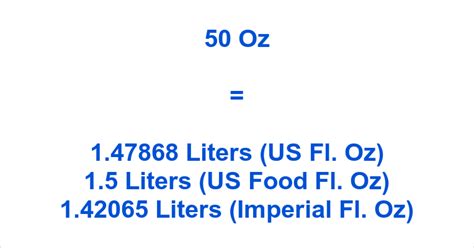50 Oz Is How Many Liters
Kalali
Apr 02, 2025 · 4 min read

Table of Contents
50 oz is How Many Liters? A Comprehensive Guide to Fluid Conversions
Understanding fluid measurements can be tricky, especially when dealing with conversions between the US customary system (ounces, pints, quarts, gallons) and the metric system (milliliters, liters). This comprehensive guide will delve into the conversion of 50 fluid ounces to liters, providing you with a clear understanding of the process, the formula involved, and helpful tips for future conversions. We'll also explore the practical applications of this conversion in various scenarios.
Understanding the Units: Ounces and Liters
Before diving into the conversion, let's briefly review the units involved:
-
Fluid Ounce (fl oz): A unit of volume in the US customary system. It's important to note that there's a difference between fluid ounces and avoirdupois ounces (used for weight). We're focusing on fluid ounces here.
-
Liter (L): A unit of volume in the metric system. A liter is a slightly larger unit than a US quart.
The Conversion Formula: From Ounces to Liters
The conversion from fluid ounces to liters is straightforward. The key conversion factor is:
1 fluid ounce (fl oz) ≈ 0.02957 liters (L)
This means that one fluid ounce is approximately equal to 0.02957 liters. The "approximately equal to" symbol (≈) is used because the conversion is not exact; it's a rounded value for practical purposes. A more precise value might be used in scientific applications, but this approximation is sufficient for most everyday needs.
To convert 50 fluid ounces to liters, we simply multiply the number of ounces by the conversion factor:
50 fl oz × 0.02957 L/fl oz ≈ 1.4785 L
Therefore, 50 fluid ounces is approximately equal to 1.4785 liters. For most practical purposes, you can round this to 1.48 liters.
Practical Applications: Where You Might Need This Conversion
Understanding the conversion between fluid ounces and liters is crucial in various situations:
1. Cooking and Baking:
International recipes often use metric measurements. If you're following a recipe that specifies ingredients in liters, and you only have measuring cups calibrated in ounces, this conversion becomes essential. For instance, if a recipe calls for 1.5 liters of liquid and you need to measure it in ounces, you'd perform the reverse calculation.
2. Traveling Internationally:
Many countries use the metric system, so understanding these conversions is vital for navigating different unit systems when traveling. Whether you're buying bottled water, filling up your car with gas, or understanding dosage instructions for medication, knowing how to convert fluid ounces to liters is essential.
3. Scientific Experiments and Research:
In scientific contexts, precise measurements are critical. While scientists might use more precise conversion factors, understanding the basic conversion between ounces and liters provides a foundation for more complex calculations.
4. Purchasing and Selling Products:
Many products, especially beverages, might be labeled in either fluid ounces or liters. Being able to convert between the two systems allows for a clear comparison of prices and volumes.
5. Healthcare and Medicine:
Dosages for medications are often specified in milliliters or liters. Converting from fluid ounces to liters is important for ensuring accurate dosage when dealing with liquid medications.
Beyond 50 oz: Mastering Fluid Conversions
While we've focused on converting 50 fluid ounces to liters, the principle remains the same for other quantities. Simply multiply the number of fluid ounces by 0.02957 to obtain the equivalent in liters.
Example:
Let's convert 25 fluid ounces to liters:
25 fl oz × 0.02957 L/fl oz ≈ 0.73925 L (approximately 0.74 liters)
Inverse Conversion: Liters to Fluid Ounces
Sometimes, you'll need to convert liters to fluid ounces. The inverse conversion factor is:
1 liter (L) ≈ 33.814 fluid ounces (fl oz)
To convert liters to fluid ounces, multiply the number of liters by 33.814.
Dealing with Different Types of Ounces
Remember that there's a distinction between fluid ounces (for volume) and avoirdupois ounces (for weight). The conversions discussed here apply specifically to fluid ounces. Confusing the two can lead to significant errors in your calculations.
Tips for Accurate Conversions
-
Use a Calculator: For precise conversions, particularly with larger numbers or more complex calculations, using a calculator is highly recommended.
-
Round Appropriately: For most practical purposes, rounding your final answer to a reasonable number of decimal places is perfectly acceptable.
-
Double-Check Your Work: Always double-check your calculations to ensure accuracy. A small mistake in the conversion factor can lead to significant errors in your final result.
-
Understand the Context: The context in which you're performing the conversion will often dictate the level of precision required.
Conclusion: Mastering Fluid Conversions for Everyday Life
Converting fluid ounces to liters is a valuable skill in various aspects of daily life. Whether you're cooking, traveling, or working in a scientific setting, understanding this conversion ensures accuracy and efficiency in your measurements. By grasping the fundamental conversion factor and applying it systematically, you can confidently navigate the world of fluid measurements. Remember the core conversion: 1 fl oz ≈ 0.02957 L, and you'll be well-equipped to handle any fluid ounce to liter conversion.
Latest Posts
Latest Posts
-
Cuanto Es 43 Grados Fahrenheit En Centigrados
Apr 03, 2025
-
Cuanto Es El 30 De 60
Apr 03, 2025
-
1 Cup Sour Cream In Oz
Apr 03, 2025
-
How Much Is 51 Inches In Feet
Apr 03, 2025
-
What Percentage Is 25 Of 75
Apr 03, 2025
Related Post
Thank you for visiting our website which covers about 50 Oz Is How Many Liters . We hope the information provided has been useful to you. Feel free to contact us if you have any questions or need further assistance. See you next time and don't miss to bookmark.
